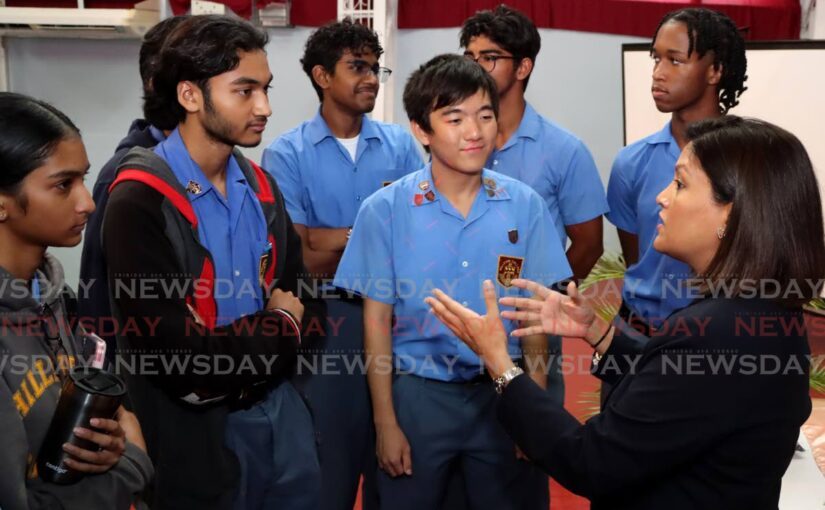Instances of censorship are growing to the point of normalization. Despite ongoing litigation and more public attention, mainstream social media has...
Vous n'êtes pas connecté
- English
- Français
- عربي
- Español
- Deutsch
- Português
- русский язык
- Català
- Italiano
- Nederlands, Vlaams
- Norsk
- فارسی
- বাংলা
- اردو
- Azərbaycan dili
- Bahasa Indonesia
- Հայերեն
- Ελληνικά
- Bosanski jezik
- українська мова
- Íslenska
- Türkmen, Түркмен
- Türkçe
- Shqip
- Eesti keel
- magyar
- Қазақ тілі
- Kalaallisut ; kalaallit oqaasii
- Lietuvių kalba
- Latviešu valoda
- македонски јазик
- Монгол
- Bahasa Melayu ; بهاس ملايو
- ဗမာစာ
- Slovenščina
- тоҷикӣ ; toğikī ; تاجیکی
- ไทย
- O'zbek ; Ўзбек ; أۇزبېك
- Tiếng Việt
- ភាសាខ្មែរ
- རྫོང་ཁ
- Soomaaliga ; af Soomaali
Rubriques :
 Maroc - NEWSDAY.CO.TT - A la Une - 30/Aug 08:07
Maroc - NEWSDAY.CO.TT - A la Une - 30/Aug 08:07
Guiding teens through online information
Dr Asha Pemberton teenhealth.tt@gmail.com OUR CURRENT media landscape is flooded with misinformation and disinformation, with facts and truth hidden in between. Between seductive pop-up ads and clickbait titles, it has become increasingly difficult to decipher which information is trustworthy. This coupled with the fact that many news outlets place legitimate content behind subscriptions or other pay-walls, young people are forced to navigate many obstacles. Alluring and free content is often simply untrue. There are also people in the online space who intentionally post disinformation for their own agenda or mischief. For whatever reason, they create fake accounts with the explicit goal of spreading disinformation, creating confusion and then finding humour it in all. In addition, online influencers play an important role in the information thought to be credible by young people. Some influencers do take the time to share accurate and useful information. Others operate with primarily a business mind-set and may say anything to appeal to sponsors. It is quite a complicated web. Parents and caregivers are required to guide and teach young people how to interpret and process the information that they encounter online. This is required for their own decision making, education and even how they understand real-time world events. Media literacy involves the ability to find, assess and use credible information despite the extensive noise that surrounds us all. For some parents, this area is particularly overwhelming. A generation or two ago, parents were taught to generally believe information found in articles or through news outlets. With the advent of the online space, anyone can claim to be a reporter. Anyone can generate an article. It is that much more challenging to seek out authentic sources and ensure that information is verified. Misinformation is generally considered to be false information that is posted or shared without an intent of malice. Often times, senders have good intentions and pass along content for the greater good. Reports of natural disasters, accidents or even world events are rapidly shared, usually to warn or protect others. Without appropriate vetting, however, incorrect content is disseminated and can lead to confusion. Disinformation, however, is defined as the intentional and deliberate creation of dishonesty. With the advances in artificial intelligence and graphics apps, it is now almost too easy to create images or videos with authentic voices and faces spewing complete garbage. It is certainly challenging for young adolescent minds to be able to decipher fact from fiction. In the education space, it is even more important for young people to be able to fact-check, verify authors and examine content. With the explosion of online learning and virtual spaces, young people are able to access practically anything instantly. Students are moving away from hard copy and paper vessels and moving toward copy-and-paste learning. In addition to the main issue of plagiarism, students are required to understand how to research. The tools of acquiring knowledge, sifting through it and processing are the benchmarks of education. With the plethora of sites that share partially correct or frankly wrong information, there are challenges for students who are not briefed. As we await the return of school, parents are encouraged to take time to start conversations with young people regarding their online diet. Question them as to the ways in which they currently assess information and trust websites or social media feeds. There are fact-checking service sites available to assist. The primary role, however, is teaching young people to assess where they get information from and challenging them on the reasons why they may choose one site over another. Guide them to resources from verified outlets, higher education centres or resource pages, as opposed to those run by a single individual. It is certainly a complex and ever changing space, but young people are required to be able to distinguish between real information and its convoluted version, toward their own safety, education and lifelong learning. The post Guiding teens through online information appeared first on Trinidad and Tobago Newsday.
Articles similaires
Cancer of School Indiscipline
“The undisciplined are slaves to moods, appetites and passions” – Stephen Covey ALL SOCIETAL institutions, both formal and informal, are...
Snap school poll: Youth want to leave Trinidad and Tobago
IN a school hall filled with 200 pupils, about half of them indicated they wished to leave Trinidad and Tobago to study, and of these only one said...
Ghanaian don tells youths to embrace entrepreneurship
A Ghanaian don, Prof. Kwando Owusu, has asked Nigerians, especially youths to embrace entrepreneurship and innovation in tackling the myriad of...
School violence – a TTUTA perspective
THE ISSUE of school violence has been with us for a long time. Even as we try to grapple once again with this issue, TTUTA as its contribution to...
Leaked chats link MAGA 'poll watcher' group to hardcore militias: report
Leaked online chats from a prominent pro-Trump group of "poll watchers" reveal close ties to an infamous armed militia movement, reported The Guardian...
Patent Monopolies And PBMs: Protectionism Leads To Corruption – OpEd
Last week I saw a somewhat shabbily dressed man in the pharmacy trying to get a Covid booster. They told him it would cost $130. (It was the Moderna...
The Fourth Branch Of US Government Faces A Reckoning – OpEd
By Kimberlee Josephson Jeff Bezos recently released an op-ed on why the Washington Post will be refraining from endorsing political candidates...
Meet The Commercial Agent: Susan Iriarte, Royal LePage Real Estate Services Ltd.
Welcome to Meet the Agent, an ongoing series profiling real estate agents from across Canada. With more than 150,000 agents, brokers, and salespeople...
Fox News is the reason the race is close
This is my last column before the election. I am as tired of writing about politics as most Americans are tired of reading, thinking, and hearing...
Les derniers communiqués
-
Aucun élément







